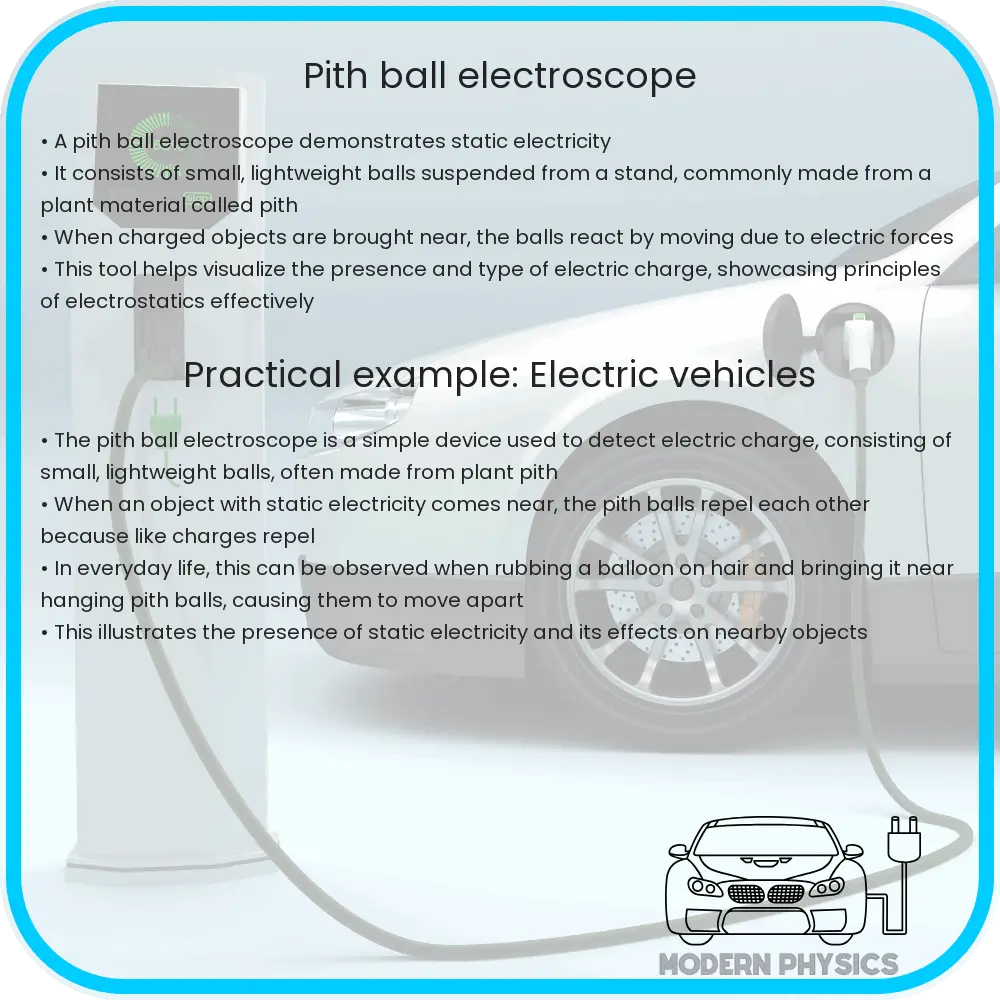Explore the pith ball electroscope’s role in detecting and understanding electric charges, its historical significance, and educational uses.

Understanding the Pith Ball Electroscope: Precision, Charge, and Detection
The pith ball electroscope is a simple yet effective device used in physics to demonstrate the presence and nature of electric charges. This device, though rudimentary in its construction, plays a crucial role in understanding fundamental concepts of electrostatics. The electroscope consists of a lightweight ball made from plant pith or a similarly lightweight material, suspended by a non-conductive thread. Its operation is based on the principles of electrostatic attraction and repulsion.
Principles of Operation
The pith ball electroscope operates on the basic principle that like charges repel, while unlike charges attract. When an object with a known charge is brought near the pith ball, the ball reacts by either moving towards or away from the object. This movement indicates whether the object is positively or negatively charged and whether the charge is stronger or weaker than the charge on the ball. This simple mechanism allows for the detection and basic analysis of static electrical charges.
Precision and Sensitivity
While not as precise as modern electronic devices, the pith ball electroscope offers a surprisingly sensitive means of detecting static electricity. Its sensitivity is influenced by factors such as the mass of the pith ball, the length and material of the suspension thread, and environmental conditions like humidity and air currents. By minimizing these external factors, the electroscope can provide a qualitative measure of electrostatic charge.
Applications in Education and Basic Research
The pith ball electroscope finds its most common use in educational settings. It serves as an excellent tool for demonstrating the basics of electrostatics to students. In historical contexts, this device was also used in early research into electricity. While it has been largely replaced by more advanced instruments in professional research environments, its simplicity and ease of use make it an enduring educational tool.
Conclusion
In conclusion, the pith ball electroscope is a fundamental tool in the study of electrostatics. Its simplicity in design belies its effectiveness in demonstrating the presence and nature of electric charges. Although it may not match the precision of modern electronic instruments, its educational value remains undisputed, making it a staple in physics classrooms worldwide.
Enhancing Understanding of Electrostatic Forces
The pith ball electroscope not only detects the presence of static electricity but also helps in understanding the nature of electrostatic forces. When a charged object is brought near the pith ball, the ball’s movement can indicate the type of charge present. For instance, if the pith ball is initially neutral, it will be attracted to a charged object, regardless of the object’s charge. This demonstrates the concept of induced charge, a fundamental aspect of electrostatics.
Quantitative Analysis
While primarily qualitative, the pith ball electroscope can also be used for basic quantitative analysis. By measuring the angle of deflection of the pith ball, one can infer the relative strength of the electrostatic force acting upon it. This application, although limited in precision, provides a hands-on method for students to grasp the relationship between charge intensity and force exerted.
Improvements and Variations
Over the years, various improvements have been made to the traditional pith ball electroscope. The use of lightweight and highly responsive materials, such as aluminum foil or gold leaf, has enhanced the sensitivity and responsiveness of these devices. Moreover, modern versions often incorporate a scale or protractor to facilitate the measurement of deflection angles, enabling more precise observations.
Significance in the History of Science
The pith ball electroscope also holds historical significance. It was one of the earliest tools used to study and understand electricity. Pioneers in the field of electromagnetism, such as Benjamin Franklin, employed versions of the electroscope in their groundbreaking experiments. These early investigations laid the groundwork for our modern understanding of electrical phenomena.
Conclusion
In summary, the pith ball electroscope is a timeless educational tool that continues to offer valuable insights into the principles of electrostatics. Its simplicity, coupled with its ability to demonstrate complex concepts in a tangible way, makes it an indispensable instrument in physics education. Beyond its educational value, the electroscope serves as a reminder of the humble beginnings of our understanding of electricity and its evolution into the sophisticated field it is today. Its role in the history of science and in contemporary education underscores its enduring significance.
